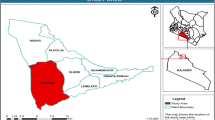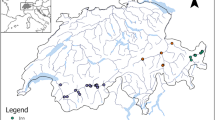Abstract
Human disturbance, natural environmental conditions and seed dispersal are often inferred as important drivers of plant community richness and diversity in wetland ecosystems. However, plant functional groups within a plant community have different environmental requirements and may respond differently to human disturbance. Therefore, the understanding of the relative importance of these variables in determining community and functional groups richness and diversity is important for improved management and wise use of wetland resources. We collected data on vegetation and environmental conditions, human disturbance and seed dispersal from 60 plots of 20 × 50 m, to identify variables that potentially affect total species richness and Shannon-Wiener diversity of the grassland plant community at the Kilombero Valley wetland, Tanzania. We further tested whether important predictor variables for species richness and Shannon-Wiener diversity differ among graminoid, forb and shrub functional groups. Overall, our results suggest that environmental conditions, human disturbance and seed dispersal determine spatial variation in species richness and Shannon-Wiener diversity of the grassland vegetation. The total richness and Shannon-Wiener diversity and the richness of shrubs decreased with distance from the Kilombero River, whereas the total Shannon-Wiener diversity and the Shannon-Wiener diversity of graminoids decreased with the increase in grazing intensity. Shrub species richness was related to the spatial position of plots and decreased with total organic carbon of soil. Current increase in human disturbances through cattle husbandry and changes in natural environmental conditions (e.g. through water diversion and drainage) should be discouraged in order to restore and sustain biodiversity of the Kilombero wetland.


Similar content being viewed by others
References
Andrew SM (2014) Plant communities of Kilombero Wetlands in Tanzania: structure, invasion and cattle grazing. PhD Disertation, Norwegian University of Life Sciences
Andrew SM, Moe SR, Totland Ø, Munishi PKT (2012) Species composition and functional structure of herbaceous vegetation in a tropical wetland system. Biodivers Conserv 21:2865–2885
Bullock JM, Hill BC, Silvertown J, Sutton M (1995) Gap colonization as a source of grassland community change: effects of gap size and grazing on the rate and mode of colonization by different species. Oikos 72:273–282
Crawley MJ (2007) The R book. Wiley, Chichester
Crawley MJ, Johnston AE, Silvertown J et al (2005) Determinants of species richness in the park grass experiment. Amer Nat 165:179–192
Dai X (2000) Impact of cattle dung deposition on the distribution pattern of plant species in an alvar limestone grassland. J Veg Sci 11:715–724
DiTommaso A, Aarssen LW (1989) Resource manipulations in natural vegetation: a review. Vegetatio 84:9–29
Frank DA, McNaughton SJ (1990) Above ground biomass estimation with the canopy intercept method: a plant growth form caveat. Oikos 57:57–60
Goodall DW (1952) Some consideration in the use of point quadrats for the analysis of vegetation. Aust J Sci Res Ser B-Biol Sci 5:1–41
Gough L, Osenberg CW, Gross KL, Collins SL (2000) Fertilization effects on species density and primary productivity in herbaceous plant communities. Oikos 89:428–439
Grime JP (2002) Plant strategies, vegetation processes, and ecosystem properties. Wiley, Chichester
Hooper D, Chapin Iii F, Ewel J et al (2005) Effects of biodiversity on ecosystem functioning: a consensus of current knowledge. Ecol Monogr 75:3–35
Jones WM, Fraser LH, Curtis PJ (2011) Plant community functional shifts in response to livestock grazing in intermountain depressional wetlands in British Columbia, Canada. Biol Conserv 144:511–517
Kangalawe RYM, Liwenga ET (2005) Livelihoods in the wetlands of Kilombero Valley in Tanzania: opportunities and challenges to integrated water resource management. Phy Chemi Earth 30:968–975
Keddy PA (2010) Wetland ecology: principles and conservation. Cambridge University, Cambridge
Kindt R, Coe R (2005) Tree diversity analysis. A manual and software for common statistical methods for ecological and biodiversity studies. World Agroforesty Centre, Nairobi
Kohler F, Gillet F, Gobat JM, Buttler A (2004) Seasonal vegetation changes in mountain pastures due to simulated effects of cattle grazing. J Veg Sci 15:143–150
Koning CO (2005) Vegetation patterns resulting from spatial and temporal variability in hydrology, soils, and trampling in an isolated basin marsh, New Hampshire, USA. Wetlands 25:239–251
Lenssen J, Menting F, van der Putten W, Blom K (1999) Control of plant species richness and zonation of functional groups along a freshwater flooding gradient. Oikos 86:523–534
Magurran AE, McGill BJ (eds) (2011) Biological diversity: frontiers in measurement and assessment. Oxford University Press, Oxford
Malo J, Suarez F (1995) Establishment of pasture species on cattle dung: the role of endozoochorous seeds. J Veg Sci 6:169–174
Merritt DM, Nilsson C, Jansson R (2010) Consequences of propagule dispersal and river fragmentation for riparian plant community diversity and turnover. Ecol Monogr 80:609–626
Milchunas DG, Lauenroth WK (1993) Quantitative effects of grazing on vegetation and soils over a global range of environments. Ecol Monogr 63:327–366
Mombo FM (2013) A new institutional economics approach to evaluate management options for wetlands: the case of Kilombero Valley wetlands in Tanzania. Ph.D. Dissertation, University of Ghent
Moran J, Skeffington MS, Gormally M (2008) The influence of hydrological regime and grazing management on the plant communities of a karst wetland (Skealoghan turlough) in Ireland. Appl Veg Sci 11:13–24
Nilsson C, Brown RL, Jansson R, Merritt DM (2010) The role of hydrochory in structuring riparian and wetland vegetation. Biol Rev 85:837–858
Økland RH, Økland T, Rydgren K (2001) Vegetation-environment relationships of boreal spruce swamp forests in Østmarka Nature Reserve, SE Norway. Sommerfeltia 29:1–190
Olff H, Ritchie ME (1998) Effects of herbivores on grassland plant diversity. Trends Ecol Evol 13:261–265
Papanikolaou AD, Fyllas NM, Mazaris AD et al (2011) Grazing effects on plant functional group diversity in Mediterranean shrublands. Biodivers Conserv 20:2831–2843
Pollock MM, Naiman RJ, Hanley TA (1998) Plant species richness in riparian wetlands-a test of biodiversity theory. Ecology 79:94–105
R Development Core Team (2011) R: a language and environment for statistical computing. R Foundation for Statistical Computing, Vienna
Rongoei P, Kipkemboi J, Kariuki S, van Dam A (2013) Effects of water depth and livelihood activities on plant species composition and diversity in Nyando floodplain wetland. Wetl Ecol Manag, Kenya. doi:10.1007/s11273-013-9313-7
Starkey M, Birnie N, Cameron A et al (2002) The Kilombero valley wildlife project: an ecological and social survey in the Kilombero Valley, Tanzania. Kilombero Valley Wildlife Project, Edinburgh
Tiner RW (1993) The primary indicators method-a practical approach to wetland recognition and delineation in the United States. Wetlands 13:50–64
Walkley A, Black IA (1934) An examination of degtjareff method for determining soil organic matter and a proposed modification of the chromic acid titration method. Soil Sci 37:29–37
Wetlands International (2013) The Ramsar sites database. http://ramsar.wetlands.org/Database/Searchforsites/tabid/765/Default.aspx. Accessed 24 September 2013
Wilsey B, Stirling G (2007) Species richness and evenness respond in a different manner to propagule density in developing prairie microcosm communities. Plant Ecol 190:259–273
Zedler J, Kercher S (2004) Causes and consequences of invasive plants in wetlands: opportunities, opportunists and outcomes. Crit Rev Plant Sci 23:431–452
Acknowledgments
This research project was funded by The Norwegian Programme for Development, Research and Education at Sokoine University of Agriculture (Project NUFU-TZ 2007/10229), and the Norwegian State Education Fund supported S.M. Andrew. District Administrative Officers for Kilombero and Ulanga districts gave permission to work in the Kilombero Valley Floodplain Wetland and District Natural Resource Officers offered logistical support. Pantaleo K. T. Munishi participated in designing the study. Lilian S. Macrice and Mlekwa Kapilima helped during fieldwork and Godson Leliyo assisted in plant collection and identification.
Author information
Authors and Affiliations
Corresponding author
Rights and permissions
About this article
Cite this article
Andrew, S.M., Totland, Ø. & Moe, S.R. Spatial variation in plant species richness and diversity along human disturbance and environmental gradients in a tropical wetland. Wetlands Ecol Manage 23, 395–404 (2015). https://doi.org/10.1007/s11273-014-9390-2
Received:
Accepted:
Published:
Issue Date:
DOI: https://doi.org/10.1007/s11273-014-9390-2




